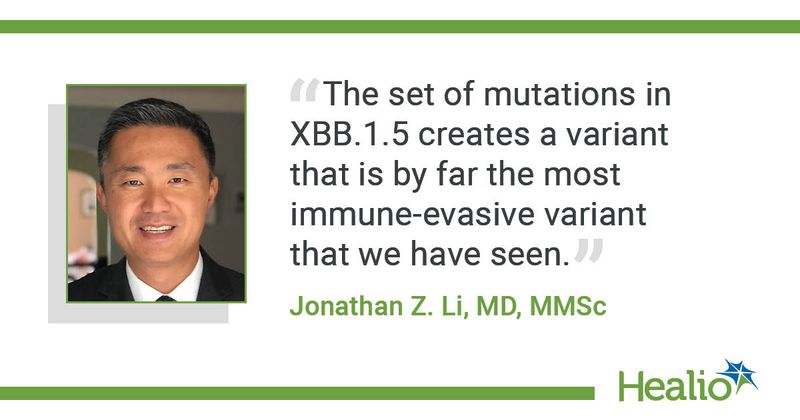XBB.1.5 finds ‘evolutionary sweet spot,’ becomes most transmissible subvariant
Click Here to Manage Email Alerts
The XBB.1.5 omicron subvariant has evolved to become the most transmissible SARS-CoV-2 subvariant yet, rapidly replacing other variants, although its ultimate impact on the pandemic is unclear, according to experts.
XBB.1.5 now accounts for nearly 28% of new cases of COVID-19 nationally, up from 4% just 4 weeks ago, according to CDC tracking.

The White House and WHO have both noted that the subvariant has surprised many with its rate of spread.
“It is the most transmissible subvariant that has been detected yet ... and we are concerned about its growth advantage,” Maria Van Kerkhove, PhD, COVID-19 technical lead for WHO, said at a press conference this week, noting that the subvariant has been detected in 29 countries.
In the Northeast U.S., the subvariant now accounts for more than 71% of new infections, according to the CDC.
“The evidence suggests that XBB.1.5 is spreading rapidly because it’s been able to find an evolutionary sweet spot that allows it to both hide from the immune system and efficiently infect our cells,” Jonathan Z. Li, MD, MMSc, associate professor of medicine at Harvard Medical School and director of the Harvard/Brigham Virology Specialty Laboratory, told Healio. “The set of mutations in XBB.1.5 creates a variant that is by far the most immune-evasive variant that we have seen.”
XBB “is the first documented example of a SARS-CoV-2 variant increasing its fitness through recombination rather than single mutations,” according to a preprint study published in December. It is a recombinant of two BA.2 sublineages, BJ.1 and BM.1.1.1, and “harbors both the immune escape-associated substitutions and the infectivity-enhancing substitutions” present in the two precursor subvariants, the authors wrote.
Li said another preprint study, uploaded on Jan. 5, suggests the subvariant has “found a new mutation that allows it to restore the ACE2 binding properties that likely allow it to infect and transmit more efficiently,” adding that it “appears to be resistant” to both Evusheld and bebtelovimab, but not the antivirals Paxlovid, remdesivir and molnupiravir.
“It has the immune escape properties of the other newer omicron subvariants — I sometimes refer to them as ‘Scrabble variants’ — but in addition, mutations at the 486 amino acid position appear to confirm improved interactions with the ACE2 receptor, and this may account for increased transmissibility,” Peter J. Hotez, MD, PhD, dean of the National School of Tropical Medicine at Baylor College of Medicine and co-director of the Texas Children’s Hospital for Vaccine Development, told Healio.
According to the CDC, the most common circulating subvariant currently is BQ.1.1, making up roughly 34% of new cases, followed by XBB.1.5 at 27.6%, BQ.1 at 21.4% and XBB at 4.9%.
“We still aren’t completely sure, but it’s important to note that while the percentage of cases being caused by XBB.1.5 is going up, the total number of COVID-19 cases is increasing at a slower rate,” Andrew S. Pekosz, PhD, professor and vice chair of the department of molecular microbiology and immunology at the Johns Hopkins University Bloomberg School of Public Health, told Healio.
“This may mean that XBB.1.5 has some increased ability to spread, but it’s not a massive increase,” Pekosz said. “If it were a massive increase, we would see total case numbers increasing at a much higher rate.”
Kerkhove said there is no indication yet that the severity of illness caused by XBB.1.5 is greater compared with other subvariants.
“But that is something that we are watching very closely through experimental studies in the lab [and] also in real world data,” she said.
Pekosz said SARS-CoV-2 continues to do “what viruses like influenza do,” picking up mutations that eventually allow new variants to dominate, but that the coronavirus is doing it much more frequently. Even so, he expects severe disease and death will not increase with new subvariant.
“The XBB group of omicron variants has a large number of mutations that make it less recognizable to vaccine- or infection-induced immunity,” Pekosz said. “However, bivalent boosters should still provide protection from severe disease, even though [they] won’t be as good at stopping infections. It should still [also] be susceptible to the antiviral drug Paxlovid.”
References:
- CDC. COVID data tracker: Variant proportions. https://covid.cdc.gov/covid-data-tracker/#variant-proportions. Accessed Jan. 6, 2023.
- Tumura, T, et al. bioRxiv. 2022;doi:10.1101/2022.12.27.521986.
- WHO press conference on global health issues. https://www.who.int/multi-media/details/who-press-conference-on-global-health-issues---4-january-2023. Published Jan. 4, 2023. Accessed Jan. 6, 2023.
- Yue, C, et al. bioRxiv. 2023;doi:10.1101/2023.01.03.522427.

